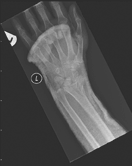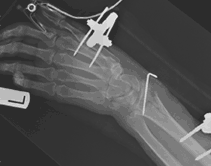Shift in distal radius fracture treatment addresses understanding fracture type
Panelist advises against external fixation with rim shear fractures. The divide on casting remains.
![OTA [logo] OTA [logo]](/~/media/images/news/print/orthopedics-today/2007/01_january/ota_150_67_20204.gif) Researchers are re-evaluating the treatment of distal radius fractures. At the Orthopaedic Trauma Association’s annual meeting, researchers in the field discussed the factors behind this change and options for care in young patients with high-energy injuries as well as low-energy fractures in elderly patients.
Researchers are re-evaluating the treatment of distal radius fractures. At the Orthopaedic Trauma Association’s annual meeting, researchers in the field discussed the factors behind this change and options for care in young patients with high-energy injuries as well as low-energy fractures in elderly patients.
“There are perspectives in our teaching that are stimulating our re-looking at these fractures from every level,” Jesse B. Jupiter, MD, chief of hand and upper extremity service at Massachusetts General Hospital, said during the presentation. He noted that the prevalence of these fractures will increase with the aging population, making fracture treatment a major public health issue.
Researchers have also gained a better understanding of the variety of distal radius fractures. “We no longer can accept the term ‘Colles fractures,’ and all of these injuries are quite different,” Jupiter said. He pointed to recent research that showed that hyperextension caused carpal ligaments to stretch and produce different fracture patterns.
“And we are beginning to understand that the ulnar column influences management and the outcome,” Jupiter said. “You know, we used to think that supination was the critical factor, but now … pronation, or lack there of, is the source of angst in many patients.” Instead of taking a wait-and-see approach, surgeons are individualizing treatment according to fracture type as well as patient factors such as age and independence.
Despite these advances, the field remains divided regarding the role of casting, early motion and external fixation. Jupiter pointed to a study by Has J. Kreder, which found that 8.5% of casted patients required reoperation.
“There probably is a place for cast treatment in minimally and nondisplaced fractures that remain stable after closed reduction, and then [there are] those patients with lower demands [who] might tolerate the malunion,” Jupiter said.
He also noted that Level 1 studies have not yet shown a long-term advantage of early motion compared to casting or external fixation. He highlighted another study by Kreder and Michael D. McKee with 179 patients, which showed no significant difference in results or complications comparing external vs. internal fixation.
“So there are reasons to operate on all of these [distal radius fractures], but certainly the level of evidence remains to be seen,” Jupiter said. “These are becoming a public health issue due to the frequency. There are different fracture patterns and there are different methods of treatment, but I would be careful of trends and the seduction of metal until acceptable science is applied.”
High-energy injuries
High-energy distal radius fractures in young patients present special concerns. “Before you talk specifically about what kind of treatment you plan to use … you need to remember some of these general considerations before you embark on treatment,” Michael D. McKee, MD, an associate professor at the University of Toronto, said during his presentation. These patients are more likely to need surgery and often present with open wounds.
“You have to be prepared for and look for what often might be a small, little hole in the volar aspect of the wrist,” McKee said. Many also have comminuted injuries and require median nerve release.
Yet, surgeons can expect to acceptably reduce fractures in 90% of these cases using external fixation and indirect reduction, McKee said. “You can improve the fracture with a low complication rate and … it’s low-cost,” he said.
In the Level 1 trial cited by Jupiter, McKee and his colleagues investigated 179 patients who received either open reduction and internal fixation (ORIF) or indirect reduction. Patients included in the study had AO type B and C displaced fractures and more than 2 mm intra-articular step-off. Patients in the indirect reduction group received closed reduction with an external fixator with or without percutaneous fixation. The comparison group underwent ORIF with conventional plates.
Postoperatively, the researchers found significantly better Musculoskeletal Functional Assessment (MFA) scores in the indirect group. McKee also noted that eight patients in the cohort were transferred to the ORIF group. “Roughly one time in 10, we were unable to obtain full reduction because the technical complexity of fracture was just not amenable to that kind of treatment. But that’s one time in 10 in trauma centers with patients aged 16-65,” he said. “So, it’s not a common thing.”
Four patients with volar wrist fractures were mistakenly included in the study. “Clearly the volar displaced wrist fracture gets better with plates and screws, and that’s what I would recommend for this kind of patient wrist fracture,” McKee said. He also cautioned against using external fixation for rim shear fractures.
|
Images: McKee M |
Low-energy injuries
In elderly patients with low-energy injuries, patient dependence and fracture instability will influence treatment. Margaret M. McQueen, MD, an orthopedist at the Edinburgh Orthopaedic Trauma Unit in Scotland, said that low-demand patients with undisplaced or displaced fractures do not need reduction. In her study of 60 dependent patients with displaced fractures who were treated with reduction, McQueen found that 53 fractures later reverted to the original position.
“So now, if my grandmother were the elderly, very low-demand, dependent patient, I would put this patient in a cast and ignore the displacement and I would let it unite in the original position,” she said during her presentation.
While researchers know that most patients have A3 type 2 or C2.1 fractures, McQueen said surgeons should perform tests to predict instability. In an analysis of 3,081 casted patients, she found that, “The increase in age, initial radial shortening, dorsal comminution and certain fractures of the AO type, and whether or not the patients were independent, all have a very significant influence on instability.” For treating these patients, McQueen suggested nonspanning external fixation for unstable fractures in independent patients. In her own Level 1 study comparing nonbridging and bridging external fixation, McQueen found a significant anatomic improvement in the nonbridging group.
“Twenty-eight out of 30 patients in our non-bridge group had carpal alignment restored at a year after injury,” she said. In a subsequent study, she and her colleagues found a nine times greater chance for malunion and a three times greater chance for radial shortening with bridging vs. nonbridging.
She also advised surgeons to be cognizant of the pitfalls of locking plates, which include penetration of the radiocarpal joint and dorsal puncture.
In a study of osteoporosis patients, she discovered five malunions in 27 patients treated with the plates.
“In four of them, we had to remove the plate at follow-up,” McQueen said. She also noted other studies reporting complication rates between 23% and 32% with the plates. “I don’t think that the role of locked plates is really well defined in this situation for the elderly patient,” she said.
For more information:
- Jupiter JB. Distal radius fracture care should be individualized.
- McKee MD. High-energy polytrauma patient - My nephew hit a wall at 90 mph on his motorcycle. His wrist should be fixed with …
- McQueen MM. Low-energy injury in an elderly patient- My grandmother tripped on the rug. She should be treated with …
- All presented in Symposium III, Controversies in the management of distal radius fractures. #F-5 at the Orthopaedic Trauma Association 22nd Annual Meeting. Oct. 4-7, 2006. Phoenix.


